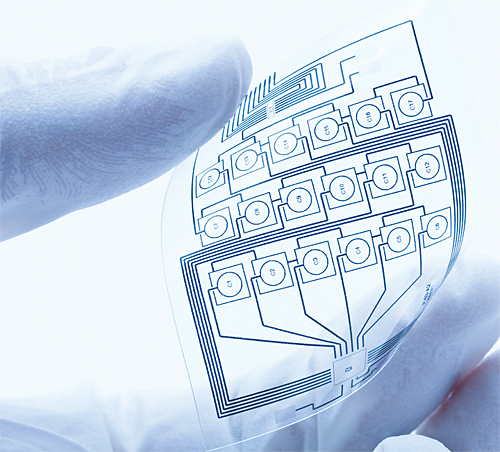By Robert Michaels, Vice-President of Technical Sales, Master Bond
The chief shortcoming of epoxy compounds is that they can be too rigid for use in some applications. Ductile adhesives, on the other hand, can better absorb the stresses caused by thermal expansion differences between the two substrates.

Toughened epoxies feature crucial performance properties that meet the needs of applications in a range of industries.
With adhesive products, high performance and rigidity are often thought to go hand in hand. And it is true that the very best strength, thermal, chemical, and electrical properties tend to be found in rigid compounds, especially epoxies. Yet there is a growing class of adhesives, sealants, and coatings that add ductility to the list of desirable epoxy properties.
These “bulked up” epoxy compounds can be created in many ways. Toughening sometimes involves incorporating ductile rubber or thermoplastic materials into the epoxy’s normally rigid molecular backbone. The ductile materials may remain in the epoxy compound as distinct phases, absorbing shear or impact forces. Carboxyl-terminated butadiene-acrylonitrile (CTBN) copolymers are one family of ductile materials.
Other toughening methods rely on specific diluents or other reactive elements to change the epoxy’s molecular structure in ways that make it more flexible by reducing the crosslink density or by shortening molecular chains. Heat cure schedules can also be manipulated to improve epoxy ductility.
Every toughening method has its advantages and disadvantages but they all address the chief shortcoming of epoxy compounds. For all their first-rate mechanical, thermal, and chemical properties, conventional epoxies can sometimes be too rigid for use in structural applications subject to extremely heavy fatigue, impact, or thermal shock loads. Toughened epoxies, though, can be used in electrical, optical, and medical applications where rigidity might otherwise prohibit epoxy usage.

Toughened epoxies are used to bond, seal, or encapsulate electronic, optical, and medical components because they stand up to challenging cyclic loads and cure with low residual stresses.
Performance benefits
When comparing toughened and conventional epoxy, elongation stands out as the primary mechanical property difference. Whereas a traditional epoxy will have elongations of less than 5%, toughened epoxies typically have elongations that fall within the range of 50% to 80%.
This elongation improvement represents an increase in ductility that allows the adhesive to withstand impacts and “flex” under cyclic loads caused by fatigue or temperature variations. The extra measure of ductility also facilitates the joining of dissimilar substrates in ways that a brittle adhesive cannot. Ductile adhesives can better absorb the stresses caused by coefficient of thermal expansion (CTE) differences between the two substrates.
Lastly, toughened compounds tend to cure with lower residual stresses than their more rigid counterparts. Unlike conventional epoxies, toughened compounds often have residual stresses approaching zero.
Ultra-low-stress curing is particularly important when bonding or encapsulating delicate electronic, optical, or medical components. These components are often made from materials whose yield stresses are far below the residual stresses possible with standard epoxies making them susceptible to damage. In optical applications, residual stresses can cause additional problems by misaligning components or inducing birefringence.
With toughened compounds, ductility comes with a small trade-off related to maximum service temperature. While high temperature epoxies can withstand intermittent temperatures above 300°C, toughened products max out at approximately 200°C intermittent. Reductions in typical continuous use temperatures are similarly about 100°C. This loss of thermal properties does not have widespread practical implications since the majority of bonding, potting, and coating applications do not require the maximum temperature resistance offered by epoxies.
This loss of thermal properties occurs at the top end of the service temperature range. At very low temperatures, which tend to magnify any ductility issues an adhesive might have, toughening actually imparts a performance advantage. Nearly all cryogenically serviceable epoxies, some of which have to withstand temperatures as low as 4°K, have some type of toughening agent.
Other than the differences in thermal properties, toughened epoxy compounds do not differ significantly from their unmodified counterparts. The chemical resistance, electrical properties, and bond strength are all comparable. So is the ease of application, with the toughened compounds available in both one- and two-part formulations. Finally, toughened adhesives offer good adhesion to many metal, plastic, glass, and rubber substrates. In the case of rubber and elastomeric substrates, toughened compounds are often a necessity. Putting a rigid compound between flexible substrates is not recommended.

Master Bond’s flexible and toughened adhesive systems resist vibration, impact, shock and thermal cycling as well as high peel and shear strength.
Toughened epoxy applications
As toughened epoxies continue to accommodate challenging load cases, they are gaining ground in a variety of applications. Many of them involve the bonding, sealing, or potting of electronic and optical components which can be sensitive to the issues that toughened compounds address: impact, vibration, thermal cycling, and stresses.
Toughened compounds are also available in versions that offer specialty properties, which open up a variety of applications that require ductility with other functional attributes. These specialty properties include electrical and thermal conductivity—NASA low outgassing specifications, electrical insulation, cryogenic serviceability, optical clarity, adjustable volume resistivity, low shrinkage, and adjustable dielectric properties.
Master Bond
www.masterbond.com
::Design World::
Filed Under: Adhesives • epoxies, FASTENING • JOINING • locks • latches • pins, Materials • advanced






Tell Us What You Think!